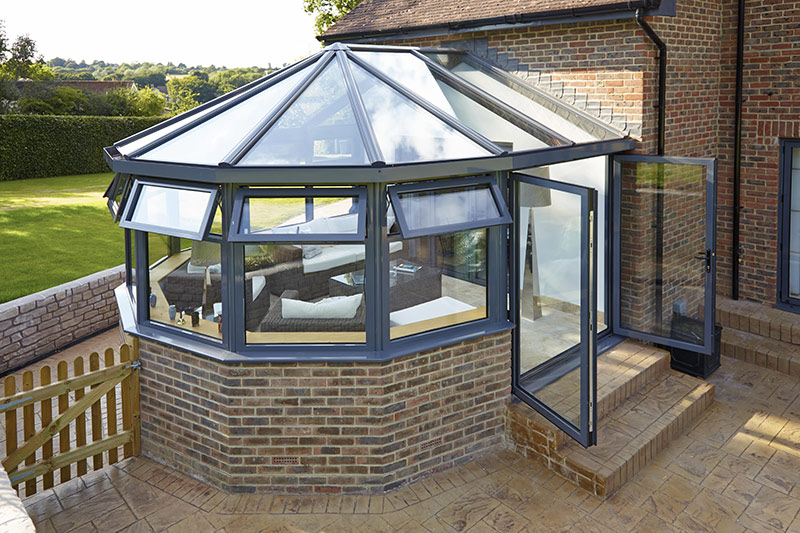Your guide - conservatories
Share
Copy Link
Conservatories were popping up everywhere in the 90s and you can see why they were such a popular choice, as they allow so much light to flood into the property. We are fortunate there is so much choice now, from classic Victorian to modern frameless, there really is a style to suit all homes and budget. They are also a brilliant way to add space to your home and could potentially add around 5-10% in value to your property.
What style of conservatories are there?
Traditional
The original choice and still a very popular option, a traditional Victorian or Edwardian style of conservatory is a smart option. These look particularly good in period homes and can come in so many colours to compliment your home. Traditionally the structure is brick on the bottom with either wood or PVCu for the frame of the glass. The roofs are pitched with the Victorian style round in shape whereas the Edwardian is square or rectangular.
Lean-to
This is the cheapest and is a great option if you are short on space or live in a bungalow. They have sloping roofs and are square in shape and are typically made from PVCu.
Modern
You can get very modern styles of conservatory made bespoke for your home. Aluminium is a popular choice of frame here as the frames can be very narrow and can support a large area of glass. Most modern conservatories are made entirely from glass and frame with no brick.
Frameless
A frameless glass conservatory can be added without any frames visible - a very modern style of conservatory that will really bring the garden into your home. These are popular for both traditional homes where they contrast with the original style, or in modern homes as a great extension to the home.

Oak Framed Conservatory by Julius Bahn
What type of material can I use for the frame of my new conservatory?
There are now so many choices of material for your new conservatory, with the most popular being PVCu, aluminium, wood & glass.
PVCu
The traditional choice of conservatory in the 80s and 90s, PVCu is low maintenance and will not rot like timber will. It's also more thermally efficient that aluminium. This is the cheapest option and is often used in off the shelf style of conservatories. However, PVCu can lack charm and character and can look grubby over the years.
Aluminium
Aluminium is a great option if you want to maximise the glass. Much stronger than PVCu, it can support large areas of glass with a small frame, making it a popular choice for a modern style of conservatory. Aluminium is a great conductor and will get very cold in the winter months, so make sure you have excellent heating in the conservatory.
Wood
A charming option, there are some beautiful oak conservatoires that really add character to a home. This is an expensive option which will need regular maintenance but often worth the investment.
Glass
The glass structure of the conservatory is supported with glass beams and fins, allowing the maximum light in and leaving the structure entirely glass.
What about the roof?
The traditional choice in the 90s was a polycarbonate roof, however a glass roof will perform far better in terms of thermal performance and allow more light into your conservatory. With the development of specialist glass, the glass roof will actively control the amount of heat and light which can enter the conservatory. You can also choose self-cleaning glass which needs less cleaning and maintenance. Polycarbonate roofs are also extremely noisy when it rains, so best to choose a glass roof if you have the budget.
Another choice is a tiled roof which will blend in with the existing property, however you will need separate building regulations for this as it is likely to be classed as an extension.

Modern glass conservatory by IQ Glass
Do I need planning permission to build a new conservatory?
Adding a conservatory is normally considered to be within permitted development, mainly because of the size, and falls under the rules of a single storey extension. To be within permitted development, the following are some of the rules that apply:
- The conservatory must be no more than 6 metres out from the rear wall of the original home for an attached property and 8 metres for a detached property
- The conservatory should be less than half the area of land around the original house
- The height can be no more than 4 metres within permitted development
There are some conservatories that you must always seek permission for, such as if you live in a conservation area or a flat or maisonette. You should always consult your local authority and confirm whether you are within the permitted development.
What about building regulations?
Many conservatories are exempt from building regulations where the following applies:
- Built at ground level and are less then 30 metres squared
- Separated from the house by external walls and thermally insulated doors
- Predominately glazed walls (otherwise it's classified as an extension)
- An independent heating system to the rest of the home with separate controls
All windows and electrics must comply with building regulations and the new conservatory should also not block access to a loft or roof access point. If you are knocking down an existing wall to gain an opening to the conservatory, then you must obtain building regulations approval.
If the new conservatory is to be open plan from part of your home, say from your existing kitchen, then this is classed as an extension and not a conservatory. Building regulations become tricky as an extension should be no more than 25% glass. You can gain approval by demonstrating that the carbon footprint of the house will be equal to or less than it would have been had the 25% max glazed area been followed.

Victorian Conservatory by Apropos
Any other regulations to consider?
If you live in a terraced or semi detached property then you may have to serve notice to your neighbours under the Party Wall etc Act 1996. Find out more by reading our article expert advice - party wall act.
Who can help me design and build my new conservatory?
There are many specialist conservatory companies that will offer a full Turnkey service including planning and overseeing the building work. You can also choose your conservatory from a specialist company and then work with your own builder, overseeing the project yourself.
How much will it cost to build a new conservatory?
The cost very much varies depending on the size, style and material used.
Off the shelf solutions can be a great option if you don't want to invest a fortune. These will start at around £6,000 for a PVCu structure. Bespoke modern conservatories can cost anything from £30,000 upwards, so a significant investment in your home.

Conservatory by Alitex
How do I best insulate my conservatory?
Conservatories are known for getting very hot in the summer and cold in the winter. Make sure you consider the following:
- Underfloor heating is great option for the winter months. This will also free up the wall space in the conservatory.
- Choose thermally efficient glass known as low-emissivity glass to stop heat from escaping
- Have appropriate ventilation, particularly if it's south-facing. Make sure you have plenty of windows were the air can flow through the conservatory.
- Solar film can be fitted to windows to block out heat and UV rays however this does tint the windows slightly
- Consider blinds in the roof of the conservatory to block out the sun in the summer, which will help keep the room cooler
- If you have the budget, then invest in an air-conditioning unit for the summer months, particularly if it's south facing
How long will it take to build?
This depends on the size and style of conservatory, but typically it should take between 4-8 weeks to build.
Anything else to consider?
Consider carefully the style of your conservatory and make sure it suits the style of your home and doesn't look like a room bolted on. Make sure it flows from the rest of your living space and consider laying the same floor and bi-fold doors or a french door so that you can open up the space to the rest of your home.
Published: October 5, 2018


